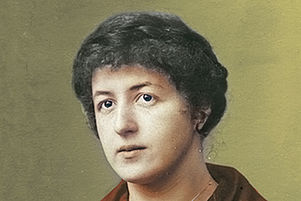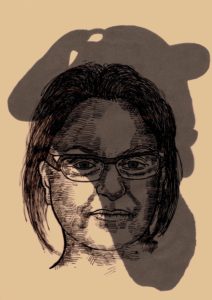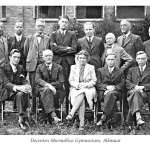3 oktober 1943
Voorheen was dit in Leiden een feestdag. Nu wacht men op de bevrijding, en we worden er gedeprimeerd en afgemat van. Het was de hele week koud en regenachtig, en beneden hebben ze de kachel al aan, wij zaten met jassen aan en met dekens om ons heen, maar vandaag is het een heldere herfstdag met veel zon. Napels is vrij, vrijdag marcheerden de geallieerden de stad binnen. De Duitsers hebben alles verwoest, zullen ze over een paar weken voor de poorten van Rome staan? Blazen ze ook de Eeuwige Stad op? De paus staat machteloos, waar blijft de hulp van gebeden, en waarom doet hij Hitler, Mussolini en alle andere schuldigen niet in de ban? Het is angst of te grote mildheid, maar goedheid in deze tijd helpt niet.
Gisteren zijn negentien jonge mensen gefusilleerd, waarschijnlijk om de moorden te wreken op NSB-politieagenten, op generaal Seyffardt, op Posthuma. Er was een Joodse student bij, Frijda, die mijn man kende. Hopelijk zijn zijn ouders niet meer in Amsterdam om deze vreselijke gebeurtenis mee te maken. Ook de vrouwelijke moordenaar op de Utrechtse commissaris Kerlen is opgepakt. Ze zeggen dat ze een halve Jodin is, Van Lier geheten. Is het werkelijk zo? Propaganda natuurlijk. Bij de negentien gefusilleerden zaten drie Boissevains, twee waren broers, vreselijk.
Ik kon niet slapen, steeds zag ik die arme mensen voor me en de ouders, de vrouwen. Wat is een mensenleven waard? Het idee dat een kind wordt doodgeschoten en te bedenken wat zich heeft afgespeeld tot het einde kwam, de laatste uren, ogenblikken. Daarom zit ik steeds zo in angst om Hans, want Joden nemen ze er altijd bij, om het even of ze schuldig zijn of niet.
Ik zie alles donker in, hoewel het aan de fronten goed gaat, vooral aan het Russische front. De laatste dagen gaat het wat langzamer. Kiev is nog niet bevrijd. Duitsland werd deze week vaak gebombardeerd. Vanuit Italië is Zuid-Duitsland nu gemakkelijk te bereiken, en München werd twee keer gebombardeerd, een keer overdag en vannacht. Ook Hannover, Emden, Braunschweig, Hagen (Westfalen). Hoe hard het ook klinkt, toch geloof ik dat deze oorlog alleen door bombardementen kan worden beslist, in een invasie in het Westen geloof ik niet.
Ik dacht dat Inge dit weekeinde zou komen, en sinds gisteren luister ik scherp naar elke voetstap, maar tevergeefs. Misschien volgende week. Zo leef je van week tot week, eindeloos lang en geen sprankje hoop. Nog nooit was ik zo afgemat, ik ben geprikkeld, en mijn man en ik kunnen dikwijls niets van elkaar hebben. En toch moet je. Ons kind is ook vaak humeurig, verveelt zich, maar ze houdt zich tamelijk goed. Maar haar natuur is veranderd. Uit het kind dat graag leerde, ontwikkelde zich een modern meisje dat heel andere ideeën heeft gekregen. Ze wil zich na de oorlog uitleven, zegt ze. Vindt ze haar weg weer als ze bij vroegere gelijkgezinden is?
Morgen eindigt de zomertijd, dan zitten we om zes uur in het donker. Vorig jaar konden we al om zes uur beneden komen, maar nu moeten we tot negen uur boven blijven. De mensen zijn bang! Geen wonder, als ze dit hadden voorzien, dan waren ze nooit aan het waagstuk begonnen, want het is en blijft een risico. De enige troost is dat ze levens redden, en verder speelt de pecunia ook een rol. Ze krijgen geld en dat gun ik de mensen. Tussen hen en ons blijft de relatie goed. We stellen geen eisen, zijn snel tevreden, leven teruggetrokken, en dat ene uur dat we in de familiekring zijn, brengen we door met lezen. Ik ben traag geworden, geen beweging, altijd zitten. Je wordt dik zonder dat je veel vet en boter krijgt. Ach, ik zou graag werken. Ik deed het vroeger zo graag, van ’s ochtends tot ’s avonds was ik in de weer, en nu? Steeds zitten, ’s morgens een beetje werken in de kamer, de afwas, maar de dag is lang.
Mijn Duitse schoonzusje Klara was jarig op 30 september, leeft ze nog?
Wim Vredenberg – CV & Research
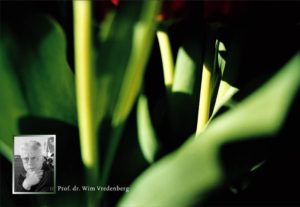 Home address
Home address
Willem J. Vredenberg
Pr. Hendrikweg 2A
NL 6721 AD Bennekom
Tel. +31 318-430303
E-mail wim.vredenberg@wur.nl
Personal data
Date of birth
7 March 1937
Qualifications
“doctorate” experimental physics, mathematics and applied mathematics, University of Utrecht, 1960
PhD Biophysics, thesis ‘Spectrophotometric Studies on Primary and Associated Reactions in Photosynthesis, University of Leiden, 1965 (promotor Prof Dr L.N.M. Duysens)
Full Professor of Plant Physiology (physical aspects), WAU, 1979
Career
1960: junior scientist Biophysics Department University Leiden
1967: principal scientist Center for Agrobiological Research, Wageningen
1970: visiting lecturer Dept Physiology and Biophysics University of Illinois, Urbana, USA (1 year)
1979: professor of Plant Physiology (physical aspects) WAU
Membership of Professional Organizations
Nederlandse Natuurkundige Vereniging
Vereniging voor Biofysica, Chairman 1988-1994
American Society of Plant Physiologists
European Society of Biophysicists
Commissie Biochemie Biofysica van de KNAW 1986-1994
Biologische Raad van de KNAW 1990-1994
Editor Photosynthetica
Research programs
Achievements
From 1979 till 1994(5) the chair of (biophysical) plant physiology at the Wageningen Agricultural University (since 2000 renamed as Wageningen University and Research (WUR)) has focused its research primarily on the interaction of plants with light as a source of energy (photosynthesis) and of information (photomorphogenesis), with special emphasis on the molecular, (bio-)physical and (eco-) physiological aspects thereof. After the merging in 1993 of the till then existing two physiological departments in the new department of Plant Physiology, the emphasis of the chair has become limited mainly to the field of photosynthesis. Research on photomorphogenesis) is now continuing within the research theme Regulation and Differentiation.
Research projects on photosynthesis have been:
Electrogenesis, energy trapping and energy coupling in chloroplasts.
The chloroplast is a perfect model of a photoelectric energy transducer. Changes in the photocurrent profiles (amplitude, rate constant) caused by single turnover or continuous energisation point amongst others to changes in conductance of longitudinal lumenal and stromal phases of the intensity folded thylakoid membrane system. They are found to be accompanied by changes of the internal chloroplast structure as concluded from EM micrographs. The dynamic properties of the thylakoid are apparently of importance for spatial distribution of generated currents and consequently for the bioenergetic performance of the plastid.
Transit sequence-triggered responses in chloroplast envelope membranes
The project aims at getting information on the nature of the membrane responses that are associated with and/or involved in the recognition and following translocation of the precursor across the envelope.
Photosystem II of photosynthesis in chloroplasts
Photosystem II not only selectively senses but also adapts efficiently to environmental stressors. Study of photometric properties of PSII in vivo (fluorescence, luminescence, absorption) offers a sensitive means to study the impact of and defensive strategies of plants against environmental factors (coordinated by Dr. J.J.S. van Rensen)
UV-B interaction with plants
Research focusses on three aspects of this interaction (i) identification of protective mechanisms,(ii) elucidation of the role of protective mechanisms in plant and ecosystem productivity, and (iii) PSII as a target for UV-B radiation
Wim Vredenberg – Publications & Links
 Publications W.J. Vredenberg, LUW, 1978-2008
Publications W.J. Vredenberg, LUW, 1978-2008
Vredenberg, W.J. and A.H.C.M. Schapendonk. Evidence for a light-induced blue band shift of part of the P515 pigment pool in intact chloroplasts. FEBS Lett. 91, 1978, 90-93.
Schapendonk, A.H.C.M. and W.J. Vredenberg. Activation of the Reaction II component of P515 in chloroplasts by pigment system 1. FEBS Letters 106, 1979, 257-261.
Schapendonk, A.H.C.M., W.J. Vredenberg and W.J.M. Tonk. Studies on the kinetics of the 515 nm absorbance change in chloroplasts. I. Evidence for the induction of a fast and slow P515 response upon saturating light flashes. FEBS Letters 100, 1979, 325-330.
Tonk, W.J.M., A.H.C.M. Schapendonk and W.J. Vredenberg. A double-compartment mixing cuvette for measuring light- and chemically-induced absorbance changes in suspensions of energy-conserving particles. J. of Biochemical and Biophysical Methods. 1, 1979, 193-194.
Schapendonk, A.H.C.M., A.M. Hemrika-Wagner, A.P.R. Theuvenet, H.W. Wong Fong Sang, W.J. Vredenberg and R. Kra. Energy-dependent changes of the electrokinetic properties of chloroplasts Biochem. – 19, 1980, 19-22.
Vredenberg, W.J. and A.H.C.M. Schapendonk. Reaction kinetics of P515 in chloroplasts. Transmembrane (reaction I) and inner membrane (reaction II) electric fields. In: Photosynthesis Vol. I, ( G. Akoyunoglou ed.) Balaban Int. Sci. Serv. Philadelphia, 1981, 489-499.
Vredenberg, W.J. P515: A monitor of photosynthetic energization in chloroplast membranes. Physiol. Plant. 53(4), 1981, 598-602.
Kooten, O. van, F.A.M. Leermakers, R.L.A. Peters, and W.J. Vredenberg. Indications for the chloroplasts as a tri-compartment system: Micro-electrode and P515 measurements imply semi-localized chemiosmosis. In: Proc. VIth Int. Congr. on Photosynthesis, ( C. Sybesma ed.) 1983, II4, 265-268.
Kooten, v. O., A.G.M. Gloudemans, and W.J. Vredenberg. On the slow component of P515 and the flash-induced reduction of cytochrome b563 in chloroplast membranes. Photobiochem. Photobiophys. 6, 1983, 9-14.
Wim Vredenberg – PhD Theses
 PhD theses Chair Biophysical Plant Physiology, Wageningen University 1980-2000
PhD theses Chair Biophysical Plant Physiology, Wageningen University 1980-2000
Schapendonk, A.H.C.M. -Electrical events associated with primary photosynthetic reactions in chloroplast membranes. -1980, Promotor Prof. Dr. W.J. Vredenberg
Brakel, G.H. van -The triplet state of chllorophyll-a in whole algal cells -1982, Promotoren Prof.T.J. Schaafsma en Prof.W.J.Vredenberg, co-referent Dr J.J.S.vRensen
Vermaas, W.F.J. -The interaction of quinones, herbicides and bicarbonate with their binding environment at the acceptor side of Photosystem II in photosynthesis. -1984, Promotoren Prof. Dr. W.J. Vredenberg en Prof.Dr G. Renger, co-promotor Dr. J.J.S. van Rensen,
Snel, J. -Regulation of photosynthetic electron flow in isolated chloroplasts by bicarbonate, formate and herbicides. -1985, Promotor Prof. Dr. W.J. Vredenberg, co-promotor Dr.J.J.S. van Rensen,
Cone, J.W. -Photocontrol of seed germination of wildtype and long-hypocotyl mutants of Arabidopsis thaliana. -1985, Promotor Prof. Dr. W.J. Vredenberg, co-promotor Dr. R.E. Kendrick,
Peters, R. -Electrochromic effects in relation to energy transduction and energy coupling in chloroplast membranes. -1986, Promotor Prof. Dr. W. J. Vredenberg,
Kraak, H.L. -Phytochrome and greening in etioplasts. -1986, Promotor Prof. Dr. W.J. Vredenberg, co-promotor Dr. R.E. Kendrick,
Kooten, O. van. -Free energy transduction. Modelling electrochemical events. -1988, Promotor Prof. Dr. W.J. Vredenberg,
Adamse, P. -Mutants as an aid to the study of higher plant photomorphogenesis. -1988, Promotor Prof. Dr. W.J. Vredenberg, co-promotor Dr. R.E. Kendrick,
Hove, L.W.A. van. -The mechanism of NH3 and SO2 uptake by leaves and its physiological effects. -1989, Promotoren Prof. Dr. E.H. Adema en Prof. Dr. W.J. Vredenberg,
Naber, J.D. -Molecular aspects of herbicide binding in chloroplasts. -1989, Promotor Prof. Dr. W.J. Vredenberg, co-promotor Dr. Ir. J.J.S. van Rensen,
Bossen, M.E. -Protoplasts as a model system to study phytochrome-regulated changes in the plasma membrane. -1990, Promotor Prof. Dr. W.J. Vredenberg, co-promotor Dr. R.E. Kendrick,
Ooms, J.J.J. -Electrochromic absorbance changes in relation to electron transport and energy coupling in thylakoid membranes. -1990, Promotor Prof. Dr. W. J. Vredenberg,
Peters, J.L. -Photomorphogenetic mutants of higher plants. -1992, Promotor Prof. Dr. W.J. Vredenberg, co-promotor Dr. R.E. Kendrick,
Schansker, G. -Mechanistic aspects of the inhibition of photosynthesis by light -1996, Promotor Prof. Dr. W.J. Vredenberg, co-promotor Dr.ir. J.J.S. van Rensen.
Kerckhoffs, Huub -Physiological Functions of Phytochromes in Tomato. A study using photomorphogenic mutants -1996, Promotor Prof. Dr. W.J. Vredenberg, co-promotor: Dr R.E. Kendrick
Voorthuysen T. van. -The electrical potential as a gauge of photosynthetic performance in plant Chloroplasts. A patch-clamp study. -1997, Promotor Prof. Dr. W.J. Vredenberg, co-promotor Dr. J.F.H. Snel.
Curwiel, V.B. -Regulation of photosynthesis and energy dissipation in triazine-resistant and susceptible chenopodium album. -1997, Promotor Prof. Dr. W.J. Vredenberg, co-promotor Dr.ir. J.J.S. van Rensen.
Geel, Corine. -Photosystem II electron flow as a measure for phytoplankton gross primary production -1997, Promotor Prof. Dr. W.J. Vredenberg, co-promotor Dr. J.F.H. Snel,
Wijngaard, P.W.J. van den -The electrophysiology of chloroplast protein import. The involvement of an anion channel in protein translocation across the inner mebrane. -1999, Promotor Prof. Dr. W.J. Vredenberg, co-promotor, Dr J.F.H. Snel
Lost Homelands, Imaginary Returns – The Exilic Literature Of Iranian And Iraqi Jews
When I first contemplated my participation in the “Moments of Silence” conference, I wondered to what extent the question of the Arab Jew /Middle Eastern Jew merits a discussion in the context of the Iran- Iraq War. After all, the war took place in an era when the majority of Jews had already departed from both countries, and it would seem of little relevance to their displaced lives. Yet, apart from the war’s direct impact on the lives of some Jews, a number of texts have engaged the war, addressing it from within the authors’ exilic geographies where the war was hardly visible. And, precisely because these texts were written in contexts of official silencing of the Iran-Iraq War, their engagement of the war is quite striking. For displaced authors in the United States, France, and Israel, the Iran-Iraq War became a kind of a return vehicle to lost homelands, allowing them to vicariously be part of the events of a simultaneously intimate and distant geography. Thus, despite their physical absence from Iraq and Iran, authors such as Nissim Rejwan, Sami Michael, Shimon Ballas, and Roya Hakakian actively participate in the multilingual spaces of Iranian and Iraqi exilic literature. Here I will focus on the textual role of war in the representation of multi-faceted identities, themselves shaped by the historical aftermath of wars, encapsulated in memoirs and novels about Iraq and Iran, and written in languages that document new stops and passages in the authors’ itineraries of belonging.
What does it mean, in other words, to write about Iran not in Farsi but in French, especially when the narrative unfolds largely in Iran and not in France? What is the significance of writing a Jewish Iranian memoir, set in Tehran, not in Farsi but in English? What are the implications of writing a novel about Iraq, not in Arabic, but in Hebrew, in relation to events that do not involve Iraqi Jews in Israel but rather take place in Iraq, events spanning the decades after most Jews had already departed en masse? How should we understand the representation of religious/ethnic minorities within the intersecting geographies of Iraq and Iran when the writing is exercised outside of the Iran-Iraq War geography in languages other than Arabic and Farsi? By conveying a sense of fragmentation and dislocation, the linguistic medium itself becomes both metonym and metaphor for a highly fraught relation to national and regional belonging. This chapter, then, concerns the tension, dissonance, and discord embedded in the deployment of a non-national language (Hebrew) and a non-regional language (English or French) to address events and the interlocutions about them that would normally unfold in Farsi and Arabic, but where French, English, and Hebrew stand in, as it were, for those languages. More broadly, the chapter also concerns the submerged connections between Jew and Muslim in and outside of the Middle East, as well as the cross-border “looking relations” between the spaces of the Middle East. Writing under the dystopic sign of war and violent dislocation, this exilic literature performs an exercise in ethnic, religious, and political relationality, pointing to a textual desire pregnant with historical potentialities.
The Linguistic Inscription of Exile
The linguistic medium itself, in these texts, reflexively highlights violent dislocations from the war zone. For the native speakers of Farsi and Arabic the writing in English, French, or Hebrew is itself a mode of exile, this time linguistic. At the same time if English (in the case of Roya Hakakian and Nissim Rejwan), French (Marjane Satrapi), and Hebrew (Sami Michael and Shimon Ballas) have also become their new symbolic home idioms. In these instances, the reader has to imagine the Farsi in and through the English and the French, or the Arabic in and through the Hebrew. Written in the new homeland, in an “alien” language, these memoirs and novels cannot fully escape the intertextual layers bequeathed by the old homeland language, whether through terms for cuisine, clothing, or state laws specifically associated with Iran and Iraq. The new home language, in such instances, becomes a disembodied vehicle where the lexicon of the old home is no longer fluently translated into the language of the new home—as though the linguistic “cover” is lifted. In this sense, the dislocated memoir or novel always-already involves a tension between the diegetic world of the text and the language of an “other” world that mediates the diegetic world.
Such exilic memoirs and novels are embedded in a structural paradox that reflexively evokes the author’s displacement in the wake of war. The dissonance, however, becomes accentuated when the “cover language” belongs to an “enemy country,” i.e., Israel/Hebrew, or United States/English. The untranslated Farsi or Arabic appears in the linguistic zone of English or Hebrew to relate not merely an exilic narrative, but a meta-narrative of exilic literature caught in-between warring geographies.
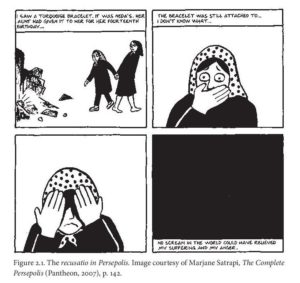
Figure 2.1. The recusatio in Persepolis. Image courtesy of Marjane Satrapi, The Complete Persepolis (Pantheon, 2007), p. 142.
Roya Hakakian’s Journey from the Land of No: A Girlhood Caught in Revolutionary Iran and Marjane Satrapi’s Persepolis both tell a coming-of-age story set during the period of the Iranian Revolution, partially against the backdrop of the Iran-Iraq War. Written by an Iranian of Muslim background (Satrapi) and by an Iranian of Jewish background (Hakakian), both memoirs are simultaneously marked by traumatic memories as well as by longing for the departed city—Tehran. Although the Jewish theme forms a minor element in Persepolis, Satrapi’s graphic memoir does stage a meaningful moment for the Muslim protagonist in relation to her Jewish friend, Neda Baba-Levy. More specifically, it treats a moment during the Iran-Iraq War when Iraqi scud missiles are raining down on Tehran, and where neighborhood houses are reduced to rubble, including the house of the Baba-Levy family. While forming only a very brief reference in the film adaptation, the chapter in the memoir, entitled “The Shabbat,” occupies a significant place in the narrative. Marjane goes out to shop and hears a falling bomb. She runs back home and sees that the houses at the end of her street are severely damaged. When her mother emerges from their home, Marjane realizes that while her own house is not damaged, Neda’s is. At that moment, Marjane hopes that Neda is not home, but soon she remembers that it is the Shabbat. As her mother pulls Marjane away from the wreckage, she notices Neda’s turquoise bracelet. Throughout her graphic novel, Satrapi does display “graphic” images, showing, for example, the torture of her beloved uncle by the Shah’s agents and then by the Islamicist revolutionaries who later execute him. Here, however, the Neda incident triggers a refusal to show what is being expressed in words. After the destruction, Satrapi writes: “I saw a turquoise bracelet. It was Neda’s. Her aunt had given it to her for her fourteenth birthday. The bracelet was still attached to . . . I do not know what..” The image illustrates the hand of little Marjane covering her mouth. In the next panel, she covers her eyes, but there is no caption. The following final panel has a black image with the caption: “No scream in the world could have relieved my suffering and my anger.”[i]
Of special interest here is precisely the refusal to show, a device referred to in the field of rhetoric as recusatio, i.e., the refusal to speak or mention something while still hinting at it in such a way as to call up the image of exactly what is being denied. In Persepolis it also constitutes the refusal to show something iconically, in a medium—the graphic memoir—essentially premised, by its very definition, on images as well as words. Marjane recognizes the bracelet, but nothing reminiscent of her friend’s hand, while her own hand serves to hide her mouth, muffling a possible scream. In intertextual terms, this image recalls an iconic painting in art history, Edvard Munch’s The Scream.
While the expressionistic painting has the face of a woman taken over by a large screaming mouth, here, Persepolis has the mouth covered; it is a moment of silencing the scream. Satrapi represses—not only visually but also verbally—the words that might provide the context for the image, i.e., what Roland Barthes calls the “anchorage” or the linguistic message or caption that disciplines and channels and the polysemy or “many-meaningedness” of the image.[ii] In this case, the caption also reflects a recusatio, in that no scream could express what she is seeing and feeling. As a result, there is a double silence, the verbal silence and the visual silence implied by the hand on the mouth, and then by the hands on the eyes culminating in the black frame image. The final black panel conveys Marjane’s subjective point of view of not seeing, blinded as it were by the horrifying spectacle of war.
Why Trump’s Racist And Neo-Fascist Campaign Strategy Resonates In 21st Century America
With the November election just around the corner, Donald Trump is raising the level of his racist and fascist rhetoric to new heights, fully aware that his hate speech and authoritarian overtures resonate with a large segment of white Americans in 21st century who, as surreal and obscene as this may sound, would have preferred that time stood still, stuck either in the era of the plantation system or at least at a time when whites in this country felt so superior to minorities that they could discriminate and oppress the “Other” without fear of getting into trouble with the law, let alone become witness to public outcries over police brutality, systemic racism, and demands for gender and racial equality.
Indeed, it is the awareness of the existence of a very large segment of white Americans in 21 st century who wish to roll back the clock on account of their growing insecurities and fears about the[ir] future that prompts Trump to sound ever more racist and project ever more the image of a strong man as time moves closer to election time. In doing so, his hope is that even moderate white voters might be stirred into feeling the need to join in on what he obviously hopes they may come to recognize and appreciate, just like his traditional base of white supremacists does, as an urgent “patriotic” campaign on the part of the “Great White Leader” to save [white] America’s soul. As for his rich supporters, he doesn’t care one way or another about the impact of his rhetoric on them because he knows they will continue supporting him as long as he maintains a steadfast course of lavishing them with gifts, such as huge tax cuts, deregulation policies, etc.
Trump’s attempt to outdo himself was most evident at his Minnesota rally a few days ago– perhaps the most extreme example so far of how far the “Great White Leader” is ready and willing to go in order to spread fear and promote hate as tactical means of securing another electoral victory in a country sharply divided into different political tribes.
And make no mistake about it: reliance on fear, hate, and violence have always been the political tools of fascists of all stripes.
Trump declared to Minnesotans that Biden would turn their state into a “refugee camp.” He warned them of “sleepy Joe Biden’s extreme plan to flood” Minnesota with refugees from Somalia, while denigrating at the same time the election of Rep. Ilhan Omar, who came to the United States as a child refugee from Somalia, calling her an “extremist”. To this insidious racist rhetoric, his fanatical base from below responded by screaming “send her back.”
Trump’s racist rhetoric hit a crescendo when he let his crowd know that they are supporting him because of their “good genes.”And to further upgrade his neo-fascist profile with his adoring crowd, he said it was “a beautiful thing” when journalist Ali Velshi got struck by a rubber bullet while covering a peaceful protest.
All in all, Trump’s performance at the Minnesota rally on September 18 was an act stolen from the electoral campaign of Hitler and his Nazi party. The only thing he fell short from saying was that anyone who did not support him should be deprived of civic rights and sent to prison or concentration camps.
No rational human being can fail to see that Trump is a racist with strong fascist impulses, but even critics of Trump fail to see or properly acknowledge that the “Great White Leader” employs the rhetoric of racism and fascism because there is a huge market for it in 21 st century America!
